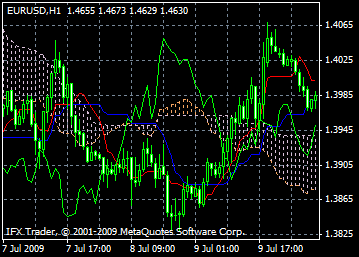Ichimoku Kinko Hyo indicator is a technical indicator following the trend. It helps traders to define support and resistance levels and gives signals to buy or sell in a way similar to one of the moving average. Thus, the Ichimoku indicator creates wider zones at the support and resistance levels, reducing the risk of false signals. Ichimoku works best on daily and weekly charts.
The Ichimoku indicator gives traders plenty of information about the current trend, its direction, as well as support and resistance levels. When setting parameters, 4 different time periods are used that are the base of values of separate lines.
The indicator consists of four main lines:
Tenkan-sen, or the conversion line, equals the sum of the lowest and highest prices for the last nine periods divided by two. This line shows the average price for the first time period.
Kijun-sen, or the base line, equals the sum of the lowest and highest prices for the last 26 periods, divided by 2. This line indicates the average price for the second period.
Senkou Span A, or the leading span line 1, is the sum of values of the base and conversion lines divided by 2 and plotted 26 periods ahead. This line is the midpoint between the previous two lines, shifted forward by the size of the second time period.
Senkou Span B, or the leading span line 2, is the sum of highest and lowest values for the past 52 periods, divided by 2 and plotted 26 periods in the future. It shows the average price value for the third time period, shifted forward by the size of the second time period.
Apart from the four main lines, there is also the fifth component of the Ichimoku Kinko Hyo indicator – Chikou Span, also known as lagging span. It shows the closing price of the current candlestick, shifted forward by the size of the second time period.
The additional area that is formed between the Senkou lines is called a cloud which is differently colored. This area shows the resistance and support levels, and also helps traders to factor in volatility of trading instruments on the forex market. The Ichimoku cloud also enables traders to define the trend direction. If quotes are above the cloud, it is a signal of an upward trend, and when they are below the cloud, it means that the trend is downward.
If the price is above the cloud, then its upper line forms the first support level and the line next to it forms the second support level. If the price is below the cloud, then the lower line represents the first resistance level and the line next to it forms the second resistance level. If Chinkou Span crosses the chart bottom-up, then it is a signal to buy. If the line crosses the chart top-down, then it is a signal to sell.
Kijun-sen is used as an indicator of market dynamics. If the price is above the base line, then they are likely to continue rising. If the price crosses this line, then the trend is likely to reverse.
This line is also used as a signal. If Tenkan-sen crosses Kijun-sen bottom-up, it is a signal to buy and if the crossing is top-down, it is a signal to sell.
When Tenkan-sen rises or falls, the trend is obvious. If this line moves horizontally, then the market is in channel.
In order to use the Ichimoku indicator, a trader needs to download and install it on a ichimoku trading platform. In MetaTrader this indicator is included in the list of standard oscillators.


The InstaForex Analyst Team
GK InstaFintech © 2007-2025















